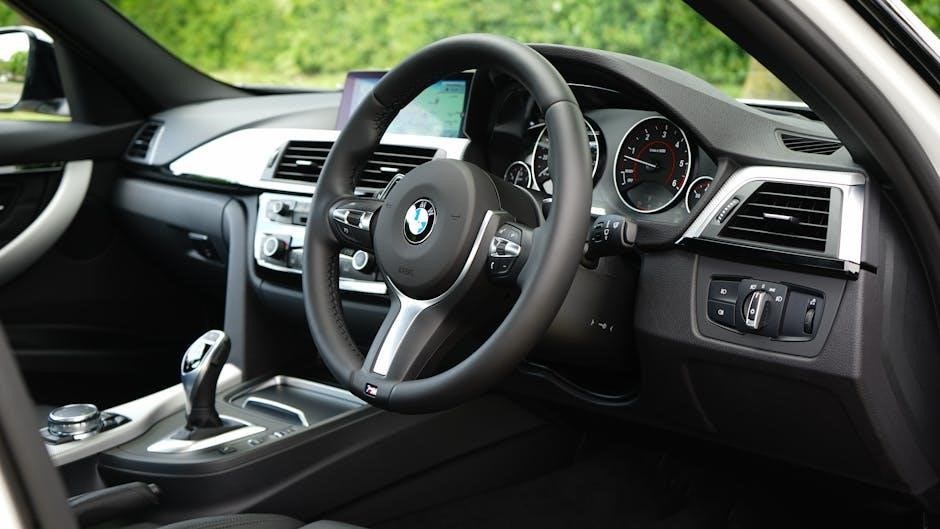Manual transmissions offer precise driver control and efficiency, with 5-speed and 6-speed variants catering to different driving needs. Understanding their differences is key to choosing the right setup.
Overview of 5-Speed and 6-Speed Manual Transmissions
A 5-speed manual transmission typically offers five forward gear ratios, providing a straightforward and simple design for everyday driving. It is commonly found in older vehicles or base models, emphasizing ease of use and reliability. On the other hand, a 6-speed manual transmission includes an additional gear, often an overdrive ratio, which enhances fuel efficiency and performance at higher speeds. The 6-speed is generally more complex but offers better control over engine RPMs, especially in varying driving conditions. Both transmissions require driver engagement, but the 6-speed is favored in sports or high-performance applications due to its closer gear spacing and improved acceleration. The choice between the two often depends on the driver’s priorities, such as simplicity, fuel economy, or performance needs.
Importance of Understanding Gear Ratios and Performance
Understanding gear ratios is crucial for optimizing a vehicle’s performance, as they directly impact acceleration, fuel efficiency, and overall driving experience. Gear ratios determine how power is delivered across different speeds, with closer ratios in 6-speed transmissions enabling smoother transitions and better control over engine RPMs. This is particularly beneficial for high-performance or racing applications, where maintaining optimal engine speed is critical. Conversely, wider gear ratios in 5-speed transmissions can provide stronger low-end torque, making them suitable for towing or hauling heavy loads. The final drive ratio also plays a significant role, as it affects the vehicle’s top speed and acceleration. By analyzing these factors, drivers can choose the transmission that best aligns with their specific needs, whether for daily commuting or high-performance driving. This understanding ensures optimal vehicle setup and enhanced driving satisfaction.

Key Differences in Gear Ratios
6-speed transmissions feature closer gear ratios for smoother acceleration and better RPM control, while 5-speeds have wider spacing, often prioritizing simplicity and stronger low-end torque delivery.
How 5-Speed and 6-Speed Transmissions Differ in Gear Spacing
The primary distinction lies in gear spacing, with 6-speed transmissions offering closer ratios to maintain optimal engine RPM during acceleration and shifting. This results in smoother power delivery and better performance, especially in racing or high-performance scenarios. In contrast, 5-speed transmissions typically have wider gaps between gears, which can lead to more significant RPM drops when shifting, particularly at higher speeds. The narrower spacing in 6-speeds allows drivers to stay within the engine’s power band more effectively, enhancing both acceleration and control. However, 5-speeds may offer simpler mechanics and reduced weight, appealing to those prioritizing durability and ease of maintenance over performance finesse.
Impact of Closer Gear Ratios in 6-Speed Transmissions
Closer gear ratios in 6-speed transmissions significantly enhance driving dynamics by minimizing RPM drops during shifts. This allows engines to stay within their optimal power range, delivering smoother acceleration and improved responsiveness. Drivers experience better control, especially in performance or racing contexts, as the engine maintains consistent power delivery through each gear change. Additionally, closer ratios can reduce the need for frequent downshifting when decelerating, providing a more seamless driving experience. While this setup excels in high-performance scenarios, it may require more precise driver input compared to the wider spaced gears of a 5-speed, which can be more forgiving for everyday driving.
Final Drive Ratios: A Comparative Analysis
Final drive ratios play a crucial role in determining a vehicle’s overall performance and efficiency. In 5-speed transmissions, the final drive ratio is often longer, providing more torque at the wheels, which is beneficial for towing and low-speed maneuvers. Conversely, 6-speed transmissions typically feature shorter final drive ratios, enabling higher top speeds and improved fuel efficiency at cruising speeds. This difference is significant because the 6-speed’s shorter ratio allows the engine to operate at lower RPMs on the highway, reducing wear and enhancing comfort. However, the 5-speed’s longer ratio can deliver better acceleration from a standstill, making it preferable for heavy-duty applications or hilly terrain. Understanding these differences helps drivers choose the optimal setup for their specific needs.
Performance Comparison
6-speed transmissions often deliver smoother acceleration and better power distribution due to closer gear ratios, while 5-speeds provide a more direct driving feel, each catering to different preferences.
Acceleration and Power Delivery in 5-Speed vs. 6-Speed
6-speed manual transmissions typically offer smoother acceleration and more consistent power delivery due to closer gear ratios, allowing engines to stay within optimal RPM ranges. This is particularly beneficial in performance driving, where maintaining torque and horsepower output is crucial. In contrast, 5-speed transmissions often have wider gaps between gears, which can result in slightly less precise power delivery but may feel more direct and engaging for some drivers. The 6-speed’s additional gear enables better control over engine speed, especially during rapid acceleration or when navigating varied terrain, making it a preferred choice for racing and high-performance applications.
Racing Performance: Which Transmission Excels?
In racing environments, 6-speed manual transmissions generally excel due to their closer gear ratios, enabling drivers to maintain optimal engine speed through corners and straights. The additional gear allows for finer control over power delivery, crucial for competitive racing where every RPM counts. While 5-speed transmissions are simpler and lighter, their wider gear spacing can lead to momentary losses in momentum during shifts. For high-power applications, 6-speed transmissions are often stronger and more durable, reducing the risk of mechanical failure under stress. Thus, racers favor 6-speeds for their precision, responsiveness, and ability to maximize engine performance, making them the preferred choice in professional racing circuits.
Towing Capacity and Load Handling
When comparing 5-speed and 6-speed manual transmissions for towing and load handling, the 6-speed generally offers better performance. Its additional gear ratio allows for finer control over engine RPM, reducing strain during heavy loads. The closer gear spacing in 6-speed transmissions helps maintain optimal power delivery, especially when towing uphill or hauling heavy trailers. In contrast, 5-speed transmissions may have wider gaps between gears, potentially leading to less efficient power utilization under load. However, the 5-speed is often lighter and simpler, making it suitable for lighter towing tasks. For heavy-duty applications, the 6-speed’s durability and precision make it the preferred choice, ensuring smoother operation and reduced wear on the engine and drivetrain.

Fuel Efficiency and Driving Experience
Fuel efficiency and driving experience vary between 5-speed and 6-speed manual transmissions. 6-speeds often provide better mileage due to closer gear ratios, optimizing engine performance. However, 5-speeds may offer a smoother, simpler driving experience for steady-speed cruising.
Fuel Economy: 5-Speed vs. 6-Speed Transmissions
Fuel economy varies between 5-speed and 6-speed manual transmissions, with 6-speeds often offering better mileage due to additional gear ratios. The 6-speed allows engines to stay within optimal RPM ranges, reducing fuel consumption, especially at higher speeds. Final drive ratios also play a role, as 6-speeds typically have shorter gearing, enhancing efficiency. In contrast, 5-speed transmissions, while simpler, may lack the finer control over engine speed, leading to slightly lower fuel efficiency. However, the difference is often minimal in real-world driving conditions. Ultimately, the choice depends on balancing fuel economy needs with other factors like performance and driving comfort.
Driving Comfort in Traffic and Daily Commuting
Driving comfort in traffic and daily commuting differs between 5-speed and 6-speed manual transmissions. The 5-speed is often praised for its simplicity and smoother shifting, making it more comfortable in heavy traffic where frequent gear changes are necessary. Its wider gear spacing reduces the need for constant shifting, which can be less tiring in stop-and-go situations. On the other hand, the 6-speed offers closer gear ratios, which can provide a more engaging driving experience but may require more frequent shifts in traffic, potentially leading to driver fatigue. However, some drivers find the precision of 6-speed transmissions more satisfying, even in daily commuting scenarios. Ultimately, personal preference plays a significant role in determining comfort and ease of use.
Shift Quality and Driver Satisfaction
Shift quality and driver satisfaction vary between 5-speed and 6-speed manual transmissions. The 5-speed is often noted for its smooth, effortless shifting, which can enhance driving comfort, especially in daily commuting. Its straightforward design typically results in a more direct and mechanical feel, appealing to drivers who prefer simplicity. In contrast, the 6-speed offers a more precise and refined shifting experience, with closer gear ratios that allow for better control during spirited driving. Some drivers find the 6-speed more engaging, as it provides a sense of connection to the vehicle’s performance. However, the additional gear can sometimes make the shifting process feel slightly more complex. Overall, the choice between the two often comes down to whether the driver prioritizes ease of use or the thrill of a more involved driving experience.

Cost and Maintenance
5-speed transmissions are generally more affordable and require less complex maintenance due to fewer components. 6-speed transmissions, while pricier, offer advanced features but may need more frequent servicing.
Price Differences Between 5-Speed and 6-Speed Transmissions
5-speed manual transmissions are typically more affordable than their 6-speed counterparts due to fewer components and simpler design. The additional gear in a 6-speed transmission increases production costs, as it requires more complex engineering, materials, and manufacturing processes. On average, a 6-speed transmission can be 10-20% more expensive than a 5-speed model. However, the price difference may vary depending on the brand, vehicle type, and specific features. While the initial cost of a 6-speed is higher, it often provides better performance and fuel efficiency, which can justify the extra expense for drivers seeking enhanced driving experiences. Ultimately, the choice depends on budget and performance priorities.
Maintenance Requirements: 5-Speed vs. 6-Speed
The maintenance requirements for 5-speed and 6-speed manual transmissions differ slightly due to their structural differences. A 5-speed transmission generally has fewer components, making it simpler and potentially cheaper to maintain. In contrast, a 6-speed transmission, with its extra gear, may require more frequent fluid changes and have higher costs for replacement parts if something breaks. Additionally, the 6-speed’s closer gear ratios might generate more heat, necessitating more frequent lubricant changes. However, the 6-speed may offer better performance and fuel efficiency, which could offset the higher maintenance costs for some drivers. Both transmissions share common maintenance needs, such as clutch replacement and gearbox servicing, but the complexity and cost can vary based on the number of gears and their arrangement.
Longevity and Durability of Each Transmission Type
Both 5-speed and 6-speed manual transmissions are known for their durability, but their longevity can vary based on usage and design. The 5-speed, with fewer components, tends to be more straightforward and reliable, making it a robust choice for everyday driving. In contrast, the 6-speed, while more complex due to the additional gear, is often built to withstand higher power outputs and stress, especially in performance-driven vehicles. However, the 6-speed’s closer gear ratios and extra components can lead to slightly more wear over time if not properly maintained. Overall, both transmissions can last for many years with proper care, but the 6-speed may require more attention to maintain its longevity compared to the simpler 5-speed design.

Practical Considerations
Choosing between 5-speed and 6-speed manuals involves considering compatibility with drive shafts, transmission mounts, and shifter boxes, as each transmission type has specific requirements for optimal performance.
Shifter Box and Transmission Mount Compatibility
When transitioning from a 5-speed to a 6-speed manual transmission, compatibility issues arise. The shifter box and transmission mounts are often specific to each gearbox type, requiring upgrades. For instance, the 6-speed transmission may demand a different shifter box configuration to accommodate the additional gear, ensuring proper shifting mechanics. Similarly, transmission mounts must align with the new gearbox’s dimensions to maintain stability and prevent vibration. Compatibility varies by vehicle make and model, so checking specifications is crucial. In some cases, a clutch master cylinder upgrade may also be necessary for the 6-speed. These mechanical adjustments ensure seamless integration and optimal performance. Always verify compatibility before making a switch to avoid operational issues.
Drive Shaft Requirements for Each Transmission
Different manual transmissions require specific drive shafts to ensure proper power delivery and prevent mechanical failure. A 5-speed transmission typically uses a drive shaft designed for its particular gear ratios and torque output. In contrast, a 6-speed transmission often demands a shorter or lighter drive shaft to accommodate the closer gear spacing and potentially higher RPM ranges. Upgrading from a 5-speed to a 6-speed may necessitate a custom or specialized drive shaft to maintain optimal drivetrain performance. Additionally, the driveshaft’s material and construction must align with the transmission’s specifications to handle stress and torque effectively. Always consult the vehicle manufacturer’s guidelines to ensure compatibility and avoid drivetrain issues. Proper drive shaft selection is vital for smooth operation and durability.
Tire Size and Axle Gear Ratio Compatibility
Tire size and axle gear ratio compatibility are crucial for optimizing performance in both 5-speed and 6-speed manual transmissions. A 5-speed transmission often pairs well with standard tire sizes and axle ratios, providing a balance between acceleration and highway cruising. In contrast, a 6-speed transmission may require larger tires or adjusted axle ratios to fully utilize its closer gear spacing and higher top-end efficiency. Mismatched tire sizes can lead to improper engine RPM levels, affecting fuel efficiency and performance. It’s essential to align tire size and axle gear ratio with the transmission’s specifications to maintain optimal drivetrain harmony and avoid unnecessary wear. Always consult the vehicle manufacturer’s recommendations for compatibility and performance optimization.

Use Cases and Preferences
5-speed manuals excel in daily driving and simplicity, while 6-speeds are preferred for performance and closer gear ratios. Driver preference often aligns with specific needs and driving styles.
When to Choose a 5-Speed Transmission
A 5-speed manual transmission is ideal for drivers prioritizing simplicity, lower costs, and ease of use. It’s well-suited for daily commuting, city driving, or light-duty vehicles where high performance isn’t a priority. The 5-speed is often more affordable to purchase and maintain, making it a practical choice for budget-conscious buyers. Additionally, its wider gear spacing makes it less demanding in traffic, offering a smoother driving experience. For drivers who don’t require the closer ratios of a 6-speed, the 5-speed provides a reliable and straightforward solution. It’s also a good option for those who prefer a lighter clutch pedal and less complex shifting, especially in scenarios where frequent gear changes aren’t necessary.
When to Choose a 6-Speed Transmission
A 6-speed manual transmission is the better choice for drivers seeking enhanced performance, control, and efficiency. It’s ideal for high-performance vehicles, racing, or towing heavy loads, as it provides closer gear ratios that keep the engine in its power band. For drivers who frequently shift gears, such as on twisty roads or in competitive settings, the 6-speed offers smoother transitions and better acceleration. Additionally, its extra gear allows for more precise speed modulation and reduced engine strain at higher speeds. However, it’s more complex and typically costs more than a 5-speed. Drivers who value superior performance, versatility, and the ability to handle demanding driving conditions will benefit most from a 6-speed transmission.
Driver Preference: Smaller vs. Larger Gearboxes
Driver preferences for 5-speed and 6-speed manual transmissions often depend on their driving habits and personal comfort. Smaller 5-speed gearboxes are favored by those who prioritize simplicity, ease of use, and a more direct driving experience. They are lighter, easier to maintain, and typically more affordable. On the other hand, larger 6-speed transmissions, while heavier and more complex, are preferred by enthusiasts who enjoy the precision and control offered by closer gear ratios. Some drivers appreciate the additional gear for smoother acceleration and better performance in various driving conditions. Ultimately, the choice between smaller and larger gearboxes comes down to whether the driver values simplicity and cost-effectiveness or performance and versatility.
The primary differences between 5-speed and 6-speed manual transmissions lie in gear ratios, performance, and practicality. A 5-speed transmission typically offers wider gear spacing, making it simpler and more cost-effective, while a 6-speed provides closer ratios for smoother power delivery and better fuel efficiency. The 6-speed often includes an additional overdrive gear, reducing engine RPM at higher speeds and enhancing comfort during long drives. However, it may require more complex engineering, leading to higher costs and maintenance needs. Drivers with high-performance or racing requirements tend to favor the 6-speed for its precision and control, whereas the 5-speed remains a practical choice for everyday commuting and lighter applications. Each transmission type caters to distinct driving preferences and needs.
Final Recommendations Based on Driving Needs
For drivers prioritizing simplicity and affordability, the 5-speed manual transmission is ideal for everyday commuting and lightweight applications. It offers reliable performance with lower maintenance costs. However, for those seeking enhanced fuel efficiency and smoother power delivery, especially on highways or in performance driving, the 6-speed transmission is recommended. The additional gear in the 6-speed provides better control over engine RPM, making it superior for towing and racing scenarios. Ultimately, the choice depends on the driver’s lifestyle and preferences. If high performance and precision are critical, opt for the 6-speed. For practicality and ease, the 5-speed remains a dependable option.
